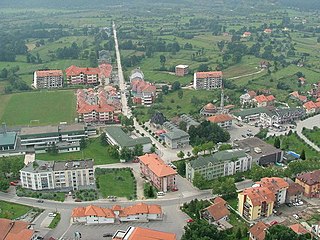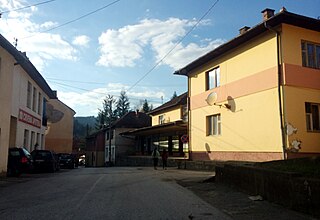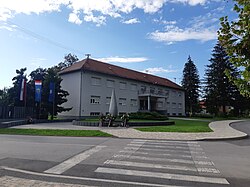
Karlovac is a city in central Croatia. In the 2021 census, its population was 49,377.

Gradačac is a city located in the Tuzla Canton of the Federation of Bosnia and Herzegovina, an entity of Bosnia and Herzegovina. It is situated in the northeastern part of Bosnia and Herzegovina, roughly 40 km (25 mi) south of the Sava river. As of 2013, it has a population of 39,340 inhabitants. The city is well known for its castle.

Cetingrad is a municipality in Karlovac County, Croatia near Croatia's border with Bosnia. The population of the village itself is 319, while the total municipality population is 2,027 (2011). The municipality is part of Kordun. Cetingrad is underdeveloped municipality which is statistically classified as the First Category Area of Special State Concern by the Government of Croatia.

Lukavac is a city located in the Tuzla Canton of the Federation of Bosnia and Herzegovina, an entity of Bosnia and Herzegovina. According to the 2013 census, the urban centre has a population of 12,061 inhabitants, with 44,520 inhabitants in the city.

Slunj is a town in the mountainous part of Central Croatia, located along the important North-South route to the Adriatic Sea between Karlovac and Plitvice Lakes National Park, on the meeting of the rivers Korana and Slunjčica. Slunj has a population of 1,674, with a total of 5,076 people in the municipality (2011) and is the cultural and social center of the region of Kordun in the vicinity to Bosnia and Herzegovina. Administratively, the town is part of Karlovac County. Slunj is an underdeveloped municipality which is statistically classified as part of the First Category Area of Special State Concern by the Government of Croatia.

Kalesija is a town and municipality located in the Tuzla Canton of the Federation of Bosnia and Herzegovina, an entity of Bosnia and Herzegovina. It is located in northeastern Bosnia and Herzegovina, east of Tuzla. As of 2013, the town has a population of 2,039 inhabitants, while the municipality has 33,053 inhabitants.

Petrinja is a town in central Croatia near Sisak in the historic region of Banovina. It is administratively located in Sisak-Moslavina County.

Donji Lapac is a settlement and a municipality in Lika, Croatia.

Ključ is a town and municipality located in the Una-Sana Canton of the Federation of Bosnia and Herzegovina, an entity of Bosnia and Herzegovina. The name of the town and the municipality translates to "Key" in English.

Rudo is a town and municipality in Republika Srpska, Bosnia and Herzegovina. As of 2013, it has a population of 7,963 inhabitants, while the town of Rudo has a population of 1,949 inhabitants.

Benkovac is a town and municipality in the Zadar County, Croatia.

Banovina or Banija is a geographical region in central Croatia, between the Sava, Una, Kupa and Glina rivers. The main towns in the region include Petrinja, Glina, Kostajnica, and Dvor. There is no clear geographical border of the region towards the west and the neighboring region of Kordun. The area of Banovina is today administratively almost entirely located within the Sisak-Moslavina County.

Brod, formerly Bosanski Brod and Srpski Brod, is a town and municipality in Republika Srpska, Bosnia and Herzegovina. It is situated on the south bank of the river Sava, in the western part of the Posavina region. As of 2013, the town has a population of 7,637 inhabitants, while the municipality has a population of 16,619 inhabitants.
Majske Poljane is a village in central Croatia, in the municipality/town of Glina, Sisak-Moslavina County. The village's geographic coordinates are 45°21′N16°8′E, the altitude is 162 meters above sea level. The village was severely affected by the 2020 Petrinja earthquake, with five deaths reported.
Muć is a village and a municipality in Croatia. It is part of the Split-Dalmatia County, located in the Zagora region near Sinj.

The Glina massacres were killings of Serb peasants in the town of Glina in the Independent State of Croatia (NDH) that occurred between May and August 1941, during World War II. The first wave of massacres in the town began on 11 or 12 May 1941, when a band of Ustaše led by Mirko Puk murdered a group of Serb men and boys in a Serbian Orthodox church before setting it on fire. The following day, approximately 100 Serb males were murdered by the Ustaše in the nearby village of Prekopi. Estimates of the overall number of Serbs killed from 11 to 13 May range from 260 to 417. Further killings in Glina occurred between 30 July and 3 August of that same year, when 700–2,000 Serbs were massacred by a group of Ustaše led by Vjekoslav Luburić.

Konjic is a City and a town located in the Herzegovina-Neretva Canton of the Federation of Bosnia and Herzegovina, one of two entities that make up Bosnia and Herzegovina. It is located in northern Herzegovina, around 60 kilometres (37 mi) southwest of Sarajevo, in a mountainous, heavily wooded area, and is 268 m (879 ft) above sea level. The municipality extends on both sides of the Neretva River. According to the 2013 census, the city of Konjic has a population of 10,732 inhabitants, whereas the municipality has 25,148.
The Novo Selo Glinsko massacre was the mass murder of Croat civilians in two separate massacres committed by Serb forces on 3 and 16 October 1991 in the village of Novo Selo Glinsko, near the town of Glina.



















